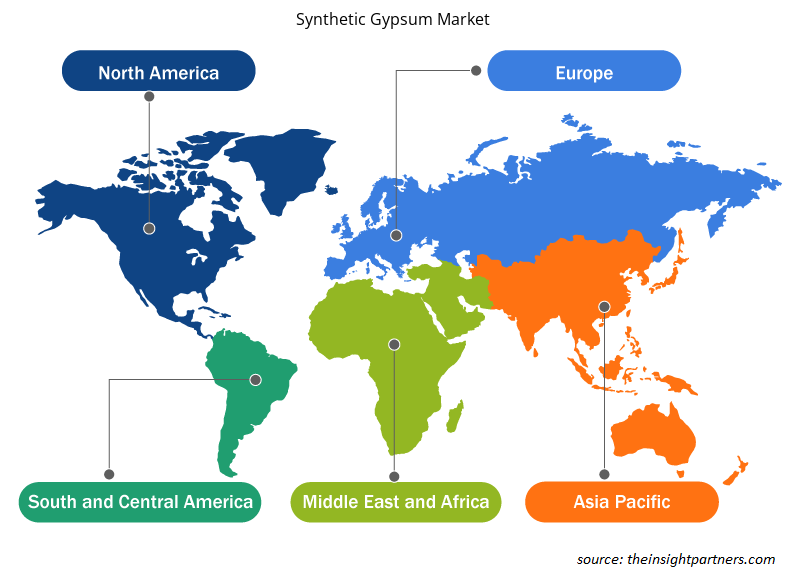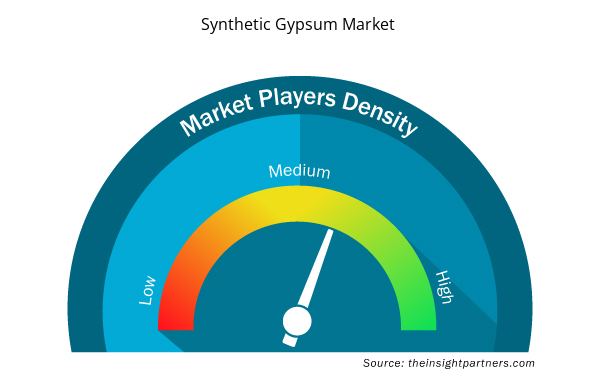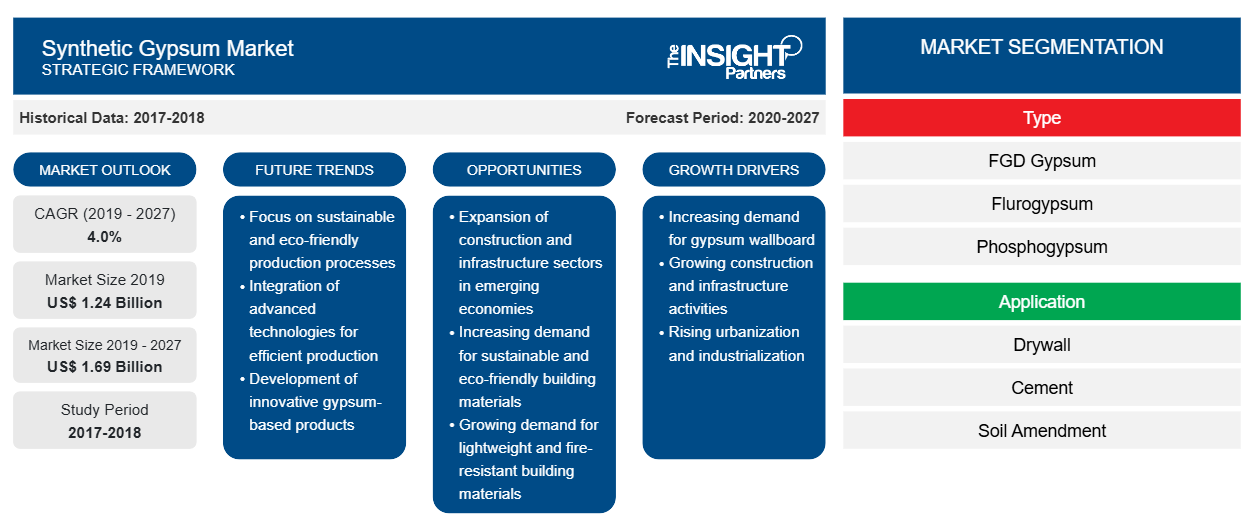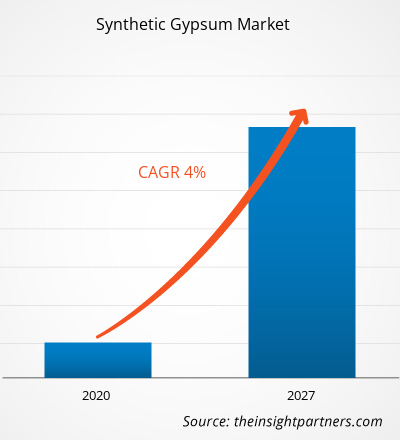[Informe de investigación] El mercado mundial de yeso sintético se valoró en US$ 1.244,02 millones en 2019 y se proyecta que alcance los US$ 1.693,72 millones para 2027; se espera que crezca a una CAGR del 4,0% entre 2020 y 2027.
El yeso sintético se utiliza principalmente en la construcción y en la agricultura. El crecimiento de la industria de la construcción en todo el mundo ha aumentado la demanda de estructuras decorativas y paneles de yeso, lo que ha impulsado la demanda de yeso sintético. Además, el uso de yeso sintético como relleno en el proceso de producción de cemento refuerza el crecimiento del mercado de yeso sintético.
En 2019, América del Norte contribuyó con la mayor participación en el mercado mundial de yeso sintético. El crecimiento del mercado en América del Norte se atribuye a la creciente industria de la construcción en los EE. UU. y al surgimiento de varias empresas de sistemas FGD en América del Norte. Debido a la creciente urbanización e industrialización, las actividades de construcción en la región están aumentando. Esto está estimulando la demanda de proyectos de renovación urbana, lo que impulsa la demanda de yeso sintético que se utiliza para fabricar cemento, paneles de yeso y estructuras decorativas.
El brote de COVID-19 está afectando negativamente a las economías e industrias en varios países debido a los confinamientos, las prohibiciones de viaje y los cierres de empresas. La industria mundial de productos químicos y materiales es una de las principales industrias que sufre graves perturbaciones, como interrupciones de la cadena de suministro, cancelaciones de eventos tecnológicos y cierres de oficinas. Por ejemplo, China es el centro de fabricación mundial y el mayor proveedor de materias primas para varias industrias, y también es uno de los países más afectados. El cierre de varias plantas y fábricas en China está restringiendo las cadenas de suministro globales e interrumpiendo las actividades de fabricación, los cronogramas de entrega y las ventas de diversos productos químicos y materiales. Varias empresas ya han anunciado posibles retrasos en las entregas de productos y una caída en las ventas futuras de sus productos. Además, las prohibiciones de viaje globales impuestas por países de Europa, Asia y América del Norte están obstaculizando las colaboraciones comerciales y las oportunidades de asociación. Todos estos factores están obstaculizando la industria de productos químicos y materiales y, por lo tanto, actúan como factores restrictivos para el crecimiento de varios mercados relacionados con esta industria.
Personalice este informe según sus necesidades
Obtendrá personalización en cualquier informe, sin cargo, incluidas partes de este informe o análisis a nivel de país, paquete de datos de Excel, así como también grandes ofertas y descuentos para empresas emergentes y universidades.
- Obtenga las principales tendencias clave del mercado de este informe.Esta muestra GRATUITA incluirá análisis de datos, desde tendencias del mercado hasta estimaciones y pronósticos.
Perspectivas del mercado
Demanda creciente de la industria de la construcción
La demanda de yeso sintético ha ido en aumento en la industria de la construcción. En la industria de la construcción, el yeso sintético se utiliza principalmente como material de relleno para el cemento y los yesos para mejorar su resistencia y también para reducir el tiempo de fraguado del hormigón. También se utiliza para hacer paneles decorativos y yeso de París. El yeso FGD, que es uno de los tipos de yeso sintético, se utiliza principalmente en la industria de la construcción para fabricar cemento, paneles de yeso y yeso de París. El yeso FGD es básicamente reciclable por naturaleza y, por lo tanto, es utilizado principalmente por los fabricantes. El yeso de París se utiliza básicamente para hacer paneles decorativos, estructuras y esculturas. La demanda de estas estructuras y esculturas está aumentando en la industria de la construcción, lo que está provocando un aumento en la demanda de yeso sintético. Los gobiernos de muchos países en desarrollo se están centrando en el desarrollo y la mejora de su infraestructura y están introduciendo muchas reformas y regulaciones que ayudarán a impulsar las industrias inmobiliaria y de infraestructura. Se espera que todas estas regulaciones y reformas tengan un impacto positivo en la industria de la construcción, lo que impulsaría la demanda de yeso sintético en el período de pronóstico.
Tipo de información
Según el tipo, el mercado de yeso sintético se segmenta en yeso FGD, yeso fluorado, yeso fosforado, yeso citral y otros. El segmento de yeso FGD lideró el mercado con la mayor participación en 2019.El yeso FGD es básicamente el yeso obtenido de los sistemas de desulfuración de gases de combustión. El azufre se elimina principalmente de los gases de combustión, lo que se puede hacer con la ayuda de cal en el sistema de desulfuración de gases de combustión. El yeso FGD tiene en su mayoría la misma identidad química que la de un yeso natural, y se considera un yeso de mayor pureza. El uso de yeso FGD se considera ecológicamente beneficioso. El yeso FGD tiene aplicaciones agrícolas y se puede utilizar en condiciones de suelo e hidrogeológicas con el fin de conservar el suelo y reciclar material industrial. El proceso mediante el cual se fabrica el yeso FGD es ecológico y proporciona una fuente ecológica de yeso puro. El yeso FGD tiene varias aplicaciones en procesos como la producción de cemento, el tratamiento del agua, la fabricación de vidrio, las aplicaciones mineras, los productos de paneles de yeso, la construcción de carreteras y la agricultura. También se puede utilizar como fuente de nutrición para los cultivos.
Algunos de los actores clave que operan en el mercado del yeso sintético son Drax Group PLC, American Gypsum, USG Corporation, Larargeholcim, Travancore Titanium Products Limited, Knauf Gips KG, Transparent Technologies Limited, BauMineral GMBH, Steag GMBH y Boral. Los principales actores del mercado se están centrando en estrategias como fusiones y adquisiciones, y lanzamientos de productos para expandir su presencia geográfica y su base de consumidores a nivel mundial.
Perspectivas regionales del mercado del yeso sintético
Los analistas de Insight Partners explicaron en detalle las tendencias y los factores regionales que influyen en el mercado de yeso sintético durante el período de pronóstico. Esta sección también analiza los segmentos y la geografía del mercado de yeso sintético en América del Norte, Europa, Asia Pacífico, Oriente Medio y África, y América del Sur y Central.

- Obtenga datos regionales específicos para el mercado de yeso sintético
Alcance del informe de mercado de yeso sintético
| Atributo del informe | Detalles |
|---|---|
| Tamaño del mercado en 2019 | 1.240 millones de dólares estadounidenses |
| Tamaño del mercado en 2027 | 1.690 millones de dólares estadounidenses |
| CAGR global (2019-2027) | 4.0% |
| Datos históricos | 2017-2018 |
| Período de pronóstico | 2020-2027 |
| Segmentos cubiertos | Por tipo
|
| Regiones y países cubiertos | América del norte
|
| Líderes del mercado y perfiles de empresas clave |
|
Densidad de los actores del mercado de yeso sintético: comprensión de su impacto en la dinámica empresarial
El mercado del yeso sintético está creciendo rápidamente, impulsado por la creciente demanda de los usuarios finales debido a factores como la evolución de las preferencias de los consumidores, los avances tecnológicos y una mayor conciencia de los beneficios del producto. A medida que aumenta la demanda, las empresas amplían sus ofertas, innovan para satisfacer las necesidades de los consumidores y aprovechan las tendencias emergentes, lo que impulsa aún más el crecimiento del mercado.
La densidad de actores del mercado se refiere a la distribución de las empresas o firmas que operan dentro de un mercado o industria en particular. Indica cuántos competidores (actores del mercado) están presentes en un espacio de mercado determinado en relación con su tamaño o valor total de mercado.
Las principales empresas que operan en el mercado de yeso sintético son:
- Grupo Drax PLC
- Yeso americano
- Corporación USG
- Larargeholcim
- Productos de titanio Travancore Limited
Descargo de responsabilidad : Las empresas enumeradas anteriormente no están clasificadas en ningún orden particular.

- Obtenga una descripción general de los principales actores clave del mercado de yeso sintético
Informe Destacado
- Tendencias progresivas de la industria en el mercado mundial de yeso sintético para ayudar a los actores a desarrollar estrategias efectivas a largo plazo
- Estrategias de crecimiento empresarial adoptadas por los mercados desarrollados y en desarrollo
- Análisis cuantitativo del mercado mundial de yeso sintético de 2017 a 2027
- Estimación de la demanda de yeso sintético en diversas industrias
- Análisis PEST para ilustrar la eficacia de los compradores y proveedores que operan en la industria para predecir el crecimiento del mercado
- Desarrollos recientes para comprender el escenario competitivo del mercado y la demanda de yeso sintético
- Tendencias y perspectivas del mercado junto con los factores que impulsan y restringen el crecimiento del mercado de yeso sintético
- Proceso de toma de decisiones mediante la comprensión de las estrategias que sustentan el interés comercial con respecto al crecimiento del mercado mundial de yeso sintético
- Tamaño del mercado de yeso sintético en varios nodos del mercado
- Descripción detallada y segmentación del mercado mundial de yeso sintético, así como su dinámica en la industria.
- Tamaño del mercado de yeso sintético en varias regiones con oportunidades de crecimiento prometedoras
Mercado de yeso sintético por tipo
- Yeso FGD
- Yeso fluorado
- Yeso fosforado
- Citroyeso
- Otros
Mercado de yeso sintético por aplicación
- Paneles de yeso
- Cemento
- Enmienda del suelo
- Dental
- Tratamiento de agua
- Otros
Perfiles de empresas
- Grupo Drax PLC
- Yeso americano
- Corporación USG
- Larargeholcim
- Productos de titanio Travancore Limited
- Knauf Yeso KG
- Tecnologías transparentes limitadas
- BauMineral GMBH
- Steag GmbH
- Boral
- Análisis histórico (2 años), año base, pronóstico (7 años) con CAGR
- Análisis PEST y FODA
- Tamaño del mercado Valor/volumen: global, regional, nacional
- Industria y panorama competitivo
- Conjunto de datos de Excel


- Blood Collection Devices Market
- Europe Tortilla Market
- Rare Neurological Disease Treatment Market
- Single-Use Negative Pressure Wound Therapy Devices Market
- Maritime Analytics Market
- Medical and Research Grade Collagen Market
- Railway Braking System Market
- Sexual Wellness Market
- Artificial Intelligence in Healthcare Diagnosis Market
- Fill Finish Manufacturing Market

Report Coverage
Revenue forecast, Company Analysis, Industry landscape, Growth factors, and Trends

Segment Covered
This text is related
to segments covered.

Regional Scope
North America, Europe, Asia Pacific, Middle East & Africa, South & Central America

Country Scope
This text is related
to country scope.
Preguntas frecuentes
Phosphogypsum is basically referred to those gypsum which are formed are mostly formed when phosphate ore is processed into fertilizer which is done through the usage of sulfuric acid. Phosphogypsum is a reusable and a safe resource which has various applications. The gypsum contains low concentration of radium which is obtained from the source rock, which must be characterized carefully because on the basis of the levels the regulators may need to specify certain restrictions. Phosphogypsum can be used in various applications in the segments like agriculture, building materials, roads construction and more. It is a multi-nutrient Sulphur rich-fertilizer which can be used as soil amendment in order to displace the high levels of sodium and magnesium salts.
The major players operating in the global avocado oil market are Drax Group PLC, American Gypsum, USG Corporation, Larargeholcim, Travancore Titanium Products Limited, Knauf Gips KG, Transparent Tehcnologies Limited, BauMineral GMBH, Steag GMBH, and Boral.
In 2019, North America contributed to the largest share in the global synthetic gypsum market. The growth of the synthetic gypsum market in North America is attributed to the construction industry in the U.S. as well as emergence of various FGD system companies in the North American region. Due to the rising urbanization and industrialization, the construction activities in the region are escalating. This is stimulating the demand for urban renewal projects which will increase the demand for synthetic gypsum that will be used in making cement, drywall and decorative structures which will drive the growth of synthetic gypsum market in North America.
Trends and growth analysis reports related to Chemicals and Materials : READ MORE..
The List of Companies - Synthetic Gypsum Market
- Drax Group PLC
- American Gypsum
- USG Corporation
- Larargeholcim
- Travancore Titanium Products Limited
- Knauf Gips KG
- Transparent Tehcnologies Limited
- BauMineral GMBH
- Steag GMBH
- Boral
The Insight Partners performs research in 4 major stages: Data Collection & Secondary Research, Primary Research, Data Analysis and Data Triangulation & Final Review.
- Data Collection and Secondary Research:
As a market research and consulting firm operating from a decade, we have published and advised several client across the globe. First step for any study will start with an assessment of currently available data and insights from existing reports. Further, historical and current market information is collected from Investor Presentations, Annual Reports, SEC Filings, etc., and other information related to company’s performance and market positioning are gathered from Paid Databases (Factiva, Hoovers, and Reuters) and various other publications available in public domain.
Several associations trade associates, technical forums, institutes, societies and organization are accessed to gain technical as well as market related insights through their publications such as research papers, blogs and press releases related to the studies are referred to get cues about the market. Further, white papers, journals, magazines, and other news articles published in last 3 years are scrutinized and analyzed to understand the current market trends.
- Primary Research:
The primarily interview analysis comprise of data obtained from industry participants interview and answers to survey questions gathered by in-house primary team.
For primary research, interviews are conducted with industry experts/CEOs/Marketing Managers/VPs/Subject Matter Experts from both demand and supply side to get a 360-degree view of the market. The primary team conducts several interviews based on the complexity of the markets to understand the various market trends and dynamics which makes research more credible and precise.
A typical research interview fulfils the following functions:
- Provides first-hand information on the market size, market trends, growth trends, competitive landscape, and outlook
- Validates and strengthens in-house secondary research findings
- Develops the analysis team’s expertise and market understanding
Primary research involves email interactions and telephone interviews for each market, category, segment, and sub-segment across geographies. The participants who typically take part in such a process include, but are not limited to:
- Industry participants: VPs, business development managers, market intelligence managers and national sales managers
- Outside experts: Valuation experts, research analysts and key opinion leaders specializing in the electronics and semiconductor industry.
Below is the breakup of our primary respondents by company, designation, and region:

Once we receive the confirmation from primary research sources or primary respondents, we finalize the base year market estimation and forecast the data as per the macroeconomic and microeconomic factors assessed during data collection.
- Data Analysis:
Once data is validated through both secondary as well as primary respondents, we finalize the market estimations by hypothesis formulation and factor analysis at regional and country level.
- Macro-Economic Factor Analysis:
We analyse macroeconomic indicators such the gross domestic product (GDP), increase in the demand for goods and services across industries, technological advancement, regional economic growth, governmental policies, the influence of COVID-19, PEST analysis, and other aspects. This analysis aids in setting benchmarks for various nations/regions and approximating market splits. Additionally, the general trend of the aforementioned components aid in determining the market's development possibilities.
- Country Level Data:
Various factors that are especially aligned to the country are taken into account to determine the market size for a certain area and country, including the presence of vendors, such as headquarters and offices, the country's GDP, demand patterns, and industry growth. To comprehend the market dynamics for the nation, a number of growth variables, inhibitors, application areas, and current market trends are researched. The aforementioned elements aid in determining the country's overall market's growth potential.
- Company Profile:
The “Table of Contents” is formulated by listing and analyzing more than 25 - 30 companies operating in the market ecosystem across geographies. However, we profile only 10 companies as a standard practice in our syndicate reports. These 10 companies comprise leading, emerging, and regional players. Nonetheless, our analysis is not restricted to the 10 listed companies, we also analyze other companies present in the market to develop a holistic view and understand the prevailing trends. The “Company Profiles” section in the report covers key facts, business description, products & services, financial information, SWOT analysis, and key developments. The financial information presented is extracted from the annual reports and official documents of the publicly listed companies. Upon collecting the information for the sections of respective companies, we verify them via various primary sources and then compile the data in respective company profiles. The company level information helps us in deriving the base number as well as in forecasting the market size.
- Developing Base Number:
Aggregation of sales statistics (2020-2022) and macro-economic factor, and other secondary and primary research insights are utilized to arrive at base number and related market shares for 2022. The data gaps are identified in this step and relevant market data is analyzed, collected from paid primary interviews or databases. On finalizing the base year market size, forecasts are developed on the basis of macro-economic, industry and market growth factors and company level analysis.
- Data Triangulation and Final Review:
The market findings and base year market size calculations are validated from supply as well as demand side. Demand side validations are based on macro-economic factor analysis and benchmarks for respective regions and countries. In case of supply side validations, revenues of major companies are estimated (in case not available) based on industry benchmark, approximate number of employees, product portfolio, and primary interviews revenues are gathered. Further revenue from target product/service segment is assessed to avoid overshooting of market statistics. In case of heavy deviations between supply and demand side values, all thes steps are repeated to achieve synchronization.
We follow an iterative model, wherein we share our research findings with Subject Matter Experts (SME’s) and Key Opinion Leaders (KOLs) until consensus view of the market is not formulated – this model negates any drastic deviation in the opinions of experts. Only validated and universally acceptable research findings are quoted in our reports.
We have important check points that we use to validate our research findings – which we call – data triangulation, where we validate the information, we generate from secondary sources with primary interviews and then we re-validate with our internal data bases and Subject matter experts. This comprehensive model enables us to deliver high quality, reliable data in shortest possible time.


 Obtenga una muestra gratuita de este informe
Obtenga una muestra gratuita de este informe